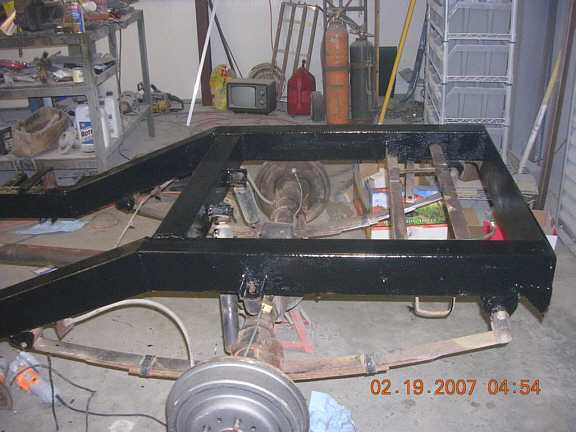| 1963 |
Prototype car built see
the prototype webpage |
| 1964 |
Oct. 1964 Company was incorporated in Florida |
| 1966 |
First year of production From
early (undated) literature: 93.4 hp slant 4, 150 hp
available at extra cost
wheelbase 100" gas tank
capacity 16 gal. 4-wheel drive avail. at extra
cost
3-speed standard. 4speed avail at extra cost. Cooling system 12.6 qts. Weight 2420 lbs
Oil capacity 4 quarts.
Colors available Flag red, jet black, snow white.
Cars had headlights attached to fenders -- no light
bar.
|
| 1967 |
From other (also undated) literature
Items in RED differ on the two brochures -Engine:
International 4-152 4cylinder. Gross BHP: 93.4 @ 4400rpm.
12volt 32 amp alternator. Cooling
system 11.6 quart capacity. Radiator frontal area
300 sq-inches.
Semi-elliptic steel leaf springs. Tires: 7.35x15 4-pr.
Brakes: Hydraulic, single-cylinder, double piston front
and rear. Size 9x2" front and rear. Total lining
area 137 sq ".Steering: S-12 gear with 17"
steering wheel.
Rear axle RA-4 2300-lib capacity. Hypoid
single-reduction, 8 1/2" ring gear. Semi-floating,
induction hardened shafts. Three piece cast iron housing.
Ration 3.73, 1.27 or 4.88 to 1
Transmission: T-13 3-speed synchromesh, direct. Ratios
3.34, 1.85, 1.0-- 4.53 reverse.
Clutch: 10" 6-spring single-plate. Hydraulic
control, vibration dampener.
Fuel tank 17 1/2 gallon
aluminum. Total car weight 2310
lbs.
Quoted in literature "Parts and service for the
complete chasis (radiator, engine, transmission,
differential, brakes, wheels and frame) available at all
International Harvester Scout dealers."
1967 Christmas Catalog for Abercrombie and Fitch featured special
"Abercrombie Runabouts" Glassics, although a bill of sale on the site
shows a sale in April of 1967. See the
Abercrombie info page
|
| 1968 |
|
| 1969 |
|
| 1970 |
Start of the transition to the Ford V-8 engine |
| 1971 |
V-8 Ford engined cars produced this year, but a
number of cars with International engines have also been
reported as showing a manufacture date in 1971 |
| 1972 |
Ford V-8 showing on all cars made this year--
about 400 cars with the International drive
train had been produced Automatic transmission
introduced
Solid, one piece bumpers
Model A style tail lights
Gas filler ON the rear pad
Car called Glassic at this time
Budweiser Special Edition sold this year. (see Flyer)
October, 1972 -- Company sold to Parker-West
|
| 1973 |
Model A style two bar bumper Auto
transmission shifter on the floor
Leaf springs front and rear
One piece hood top
Windshield wipers at top of windshield
Phaeton gas filler on rear luggage platform
a March 1974 Hemmings ad claimed for the 1973 cars
"original suggested retail $8300"
|
| 1974 |
|
| 1975 |
no cars located yet -few were produced the first half
of the year, and none the second half due to bankruptsy
of the company. |
| 1976
see article on
manufacture
date confusion. |
Rebirth of the company as Replicars. No cars sold
this year, although a few 1976's may appear with a 1977
manufacture date. The first few Replicars had SMOOTH side panels on
the hood, that is, no louvers. -- see 1976 specifications
here
The earliest Replicars had the Phaeton gas filler on the SIDE of the
rear hump. |
| 1977 |
First Replicars -- Gas filler moved from the side
of the rear hump to the rear fender.
Body
modifications began including wider doors (corrected 4/2009 - the doors
appear NOT to have been changed in width from the earlier to later
years), longer hood,
longer wheelbase
Windshield wipers on bottom of windshield
Front leaf springs, air conditioning Later in 1977 cars appeared with
Coil spring s in front.
VW tail lights and parking lights
Top of hood is split with hinge
Drum brakes - front and rear.
Car called Replicars at this time
|
In Feb. 2008 I asked Joel to
help me identify how you could tell the difference between the different
year Replicars. (If there was no VIN tag, of course). Here is his
reply - remember, this is 30 years after the fact.
Glassics all had tube axles with the Ford
engines and 5 lug wheels - Econoline spindles, drum brakes, and
probably a Maverick rear axle (5 lug)
Replicars early on had the same...w/ 3" x 4" tubing
chassis and leaf springs all around
First Replicar change was to Pinto (Mustang II)
front cross member w/ coil springs, disc brakes, & a Mustang II rack
-- and a fabricated swing arm coil spring rear suspension, disc
front, drum rear, and 4 lug wheels w/ 2" x 3" tubing chassis, and
about 2" more wheelbase to get the front tires under the crown of
the front fenders..
Later Replicar change was to the welded front cross
member (21/2" wider track), Mustang II front end "monkey motion" w/
disc brakes, & a Fairmont rack --- 4 bar rear suspension w/ coil
springs & drum brakes, probably out of a Fairmont...
When this happened is anyone's guess.. We didn't keep records of
this.
Once
I figure out what those changes LOOK like, we can try to
zero-in on when the change occurred by comparing with known VIN
cars.
|
| 1978 |
Coil springs front and rear - Mustang rear end with
the perches for the leaf springs cut off and coil springs
mounted Disc brakes in front, drum brakes in rear
Phaeton gas filler on passenger fender
Auto transmission shifter on the column (Granada
steering column)
|
| 1979 |
Somewhere between 1979 and 1980, front and rear suspension changed.
See Generation Four above. |
| 1980 |
|
| 1981 |
Last year of production - Last known car
(#1508) produced 12/30/81
Car # 1509 reported in in 12/2012, with a production date of 10/10/81 -
not surprising since VINS have appeared out of order before - possibly
when the car was ordered, not finished. |




